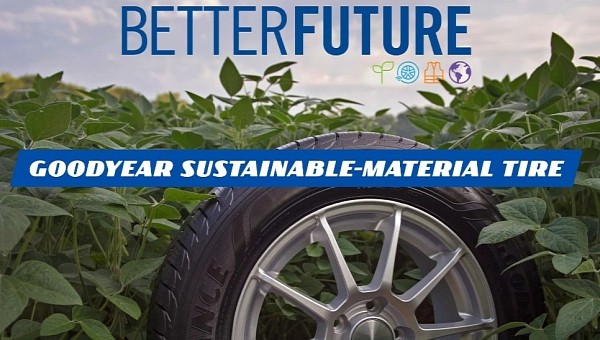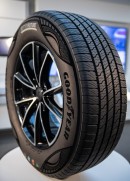A few weeks ago, Continental was very proud of its breakthrough that could change the way we sustainably source raw materials for tires. Now it’s time for Goodyear to use the magic of “sustainability” and show us a car tire prototype.
First of all, it’s a good-looking prototype. Maybe it’s weird to say something like that about a tire, but let’s face it, it does look different compared to the rest of the tires out there. And it’s definitely very different from any other tire today.
It’s made from sustainable materials. Not all of it, only 90%. This is huge because, nowadays, tires use intensive polluting materials, like carbon black or oil-based rubber. Using sustainable materials simply means less pollution. Much less.
Goodyear engineers focused on 17 featured ingredients that are used in 12 different components of the tire. And they managed to combine them so well that this demonstration tire has passed all applicable regulatory testing.
In short, this prototype could already successfully fit your car. But it’s not ready yet for mass production. Instead, all the experience gained creating it is used for developing a ready-to-sell tire with up to 70% sustainable-material content.
Interestingly, a year ago, Goodyear’s objective was to develop a demonstration tire with 70% sustainable materials. And now that value increased to 90%, while the 70% sustainable-material tire will go into production sometime this year. It proves that technology is moving very fast. In the good direction.
But let’s get back to that 17 ingredients and let’s take a look at some of them. Carbon black is the worse. There are lots of emissions when it’s made from petroleum products. Then, there’s all this fine dust because of tire wear. In the end, many end-of-life tires are burnt, and they pollute a lot.
For this prototype, Goodyear used four different types of carbon black. They are produced from methane, carbon dioxide, plant-based oil, and end-of-life tire pyrolysis oil feedstocks. The technologies used for each type of carbon black have much lower GHG emissions. Also, these types of carbon black can be efficiently recycled.
Then there is the need to keep the tire’s rubber compound pliable in changing temperatures. For a normal tire, the industry is using a petroleum-based product. But Goodyear replaced it with soybean oil made from leftovers in the food and animal feed applications. This bio-based resource also helps drastically reduce emissions.
To help improve the tire’s grip, its resistance to cutting and chipping, and to reduce fuel consumption, the industry is using silica (Silicon Dioxide - SiO2), which is simply sand, an abundant material all over the Earth. The problem is sourcing it in large quantities has a negative environmental impact, especially on rivers.
Goodyear found a way to replace it with high-quality silica produced from rice husk waste residue. RHA silica is basically a byproduct of rice processing. There are tons and tons of this stuff in landfills, especially in Asia, so using it in tires helps solve this environmental hazard.
How about using polyester bottles? Certain types of discarded plastic bottles can be reverted into base chemicals. These can be reformed into technical-grade polyester used in tire cords. Although there’s some pollution related to the recycling process, it’s better than polluting oceans and wildlife with plastic bottles.
And keep in mind that these polyesters can be recycled several times until their properties are gone and they become waste. The same goes for bio-renewable pine tree resins. They are used to replace traditional petroleum-based resins, used to help improve and enhance tire traction performance.
A very important part of the tire is the steel cords, essential for the reinforcement of the tire. They are made from steel with high-recycled content. This kind of recycled steel is produced using the electric arc furnace (EAF) process, a low GHG emissions process compared to steel produced using a blast furnace.
All of these seem like small steps of little importance. But adding them up makes a big difference. Some of the materials and processes showcased on this demonstration tire will go into production later this year for an up to 70% sustainable-material content tire.
Goodyear is already using sustainable materials like soybean oil or RHA silica in some of its current product lines. And by 2030, the American tire company wants to be the first one in the industry to sell 100% sustainable-material tires.
It’s made from sustainable materials. Not all of it, only 90%. This is huge because, nowadays, tires use intensive polluting materials, like carbon black or oil-based rubber. Using sustainable materials simply means less pollution. Much less.
Goodyear engineers focused on 17 featured ingredients that are used in 12 different components of the tire. And they managed to combine them so well that this demonstration tire has passed all applicable regulatory testing.
In short, this prototype could already successfully fit your car. But it’s not ready yet for mass production. Instead, all the experience gained creating it is used for developing a ready-to-sell tire with up to 70% sustainable-material content.
Interestingly, a year ago, Goodyear’s objective was to develop a demonstration tire with 70% sustainable materials. And now that value increased to 90%, while the 70% sustainable-material tire will go into production sometime this year. It proves that technology is moving very fast. In the good direction.
But let’s get back to that 17 ingredients and let’s take a look at some of them. Carbon black is the worse. There are lots of emissions when it’s made from petroleum products. Then, there’s all this fine dust because of tire wear. In the end, many end-of-life tires are burnt, and they pollute a lot.
For this prototype, Goodyear used four different types of carbon black. They are produced from methane, carbon dioxide, plant-based oil, and end-of-life tire pyrolysis oil feedstocks. The technologies used for each type of carbon black have much lower GHG emissions. Also, these types of carbon black can be efficiently recycled.
Then there is the need to keep the tire’s rubber compound pliable in changing temperatures. For a normal tire, the industry is using a petroleum-based product. But Goodyear replaced it with soybean oil made from leftovers in the food and animal feed applications. This bio-based resource also helps drastically reduce emissions.
To help improve the tire’s grip, its resistance to cutting and chipping, and to reduce fuel consumption, the industry is using silica (Silicon Dioxide - SiO2), which is simply sand, an abundant material all over the Earth. The problem is sourcing it in large quantities has a negative environmental impact, especially on rivers.
Goodyear found a way to replace it with high-quality silica produced from rice husk waste residue. RHA silica is basically a byproduct of rice processing. There are tons and tons of this stuff in landfills, especially in Asia, so using it in tires helps solve this environmental hazard.
How about using polyester bottles? Certain types of discarded plastic bottles can be reverted into base chemicals. These can be reformed into technical-grade polyester used in tire cords. Although there’s some pollution related to the recycling process, it’s better than polluting oceans and wildlife with plastic bottles.
And keep in mind that these polyesters can be recycled several times until their properties are gone and they become waste. The same goes for bio-renewable pine tree resins. They are used to replace traditional petroleum-based resins, used to help improve and enhance tire traction performance.
A very important part of the tire is the steel cords, essential for the reinforcement of the tire. They are made from steel with high-recycled content. This kind of recycled steel is produced using the electric arc furnace (EAF) process, a low GHG emissions process compared to steel produced using a blast furnace.
All of these seem like small steps of little importance. But adding them up makes a big difference. Some of the materials and processes showcased on this demonstration tire will go into production later this year for an up to 70% sustainable-material content tire.
Goodyear is already using sustainable materials like soybean oil or RHA silica in some of its current product lines. And by 2030, the American tire company wants to be the first one in the industry to sell 100% sustainable-material tires.






